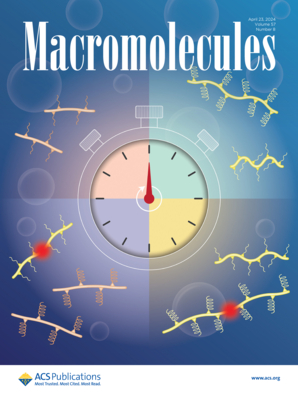Anion-Influenced Hydration and Layering Vastly Modulate Polyzwitterionic Brush Responses
IF 5.1
1区 化学
Q1 POLYMER SCIENCE
引用次数: 0
Abstract
This study investigates the influence of different anions on the hydration states and conformational changes of poly(sulfobetaine methacrylate) (PSBMA) brushes, unraveling their intricate role in modulating tribomechanical properties and antifouling performance. Through bimodal atomic force microscopy (AFM), we reveal that anion identity affects the layered structure thicknesses of PSBMA brushes in accordance with the Hofmeister series. Enhanced screening of dipole–dipole interactions and increased hydration were observed with higher concentrations of more chaotropic counterions, showcasing the anti-polyelectrolyte effect (APE), a phenomenon that was not observed in highly kosmotropic sulfate anions. Infrared spectroscopy highlighted the impact of anions on the incorporation of strongly H-bonded water clusters within the PSBMA chains. Our findings underscore the complex interplay of interfacial interactions (chain dipole–dipole, ion-chain dipole, ion–water, and water-chain dipole), leading to variations in tribomechanical behavior and antifouling performance of PSBMA brushes. Pearson correlational analysis with anion descriptors further elucidated these relationships, offering insights for tailored material design in engineering applications, thus advancing materials science and biotechnology.

受阴离子影响的水合作用和分层作用极大地调节了聚齐微电刷的反应
本研究探讨了不同阴离子对聚(甲基丙烯酸磺基甜菜碱)(PSBMA)刷的水合状态和构象变化的影响,揭示了它们在调节摩擦力学性能和防污性能方面的复杂作用。通过双峰原子力显微镜 (AFM),我们发现阴离子特性会影响 PSBMA 刷的层状结构厚度,这与霍夫迈斯特系列是一致的。各向同性反离子浓度越高,偶极子-偶极子相互作用的筛选能力越强,水合作用越强,这显示了反聚电解质效应(APE),而在高各向同性硫酸根阴离子中却观察不到这种现象。红外光谱强调了阴离子对 PSBMA 链中强 H 键水团簇结合的影响。我们的研究结果强调了界面相互作用(链偶极子-偶极子、离子-链偶极子、离子-水和水-链偶极子)的复杂相互作用,导致了 PSBMA 刷的摩擦力学行为和防污性能的变化。利用阴离子描述符进行的皮尔逊相关分析进一步阐明了这些关系,为工程应用中的定制材料设计提供了启示,从而推动了材料科学和生物技术的发展。
本文章由计算机程序翻译,如有差异,请以英文原文为准。
求助全文
约1分钟内获得全文
求助全文
来源期刊

Macromolecules
工程技术-高分子科学
CiteScore
9.30
自引率
16.40%
发文量
942
审稿时长
2 months
期刊介绍:
Macromolecules publishes original, fundamental, and impactful research on all aspects of polymer science. Topics of interest include synthesis (e.g., controlled polymerizations, polymerization catalysis, post polymerization modification, new monomer structures and polymer architectures, and polymerization mechanisms/kinetics analysis); phase behavior, thermodynamics, dynamic, and ordering/disordering phenomena (e.g., self-assembly, gelation, crystallization, solution/melt/solid-state characteristics); structure and properties (e.g., mechanical and rheological properties, surface/interfacial characteristics, electronic and transport properties); new state of the art characterization (e.g., spectroscopy, scattering, microscopy, rheology), simulation (e.g., Monte Carlo, molecular dynamics, multi-scale/coarse-grained modeling), and theoretical methods. Renewable/sustainable polymers, polymer networks, responsive polymers, electro-, magneto- and opto-active macromolecules, inorganic polymers, charge-transporting polymers (ion-containing, semiconducting, and conducting), nanostructured polymers, and polymer composites are also of interest. Typical papers published in Macromolecules showcase important and innovative concepts, experimental methods/observations, and theoretical/computational approaches that demonstrate a fundamental advance in the understanding of polymers.
 求助内容:
求助内容: 应助结果提醒方式:
应助结果提醒方式:


